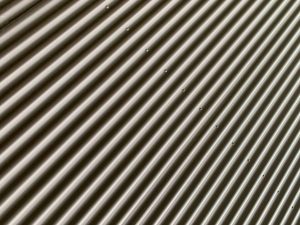 Choosing a roofing material for your home, and looking around at the roofs of neighboring buildings, you could not help but notice that one of the most popular roofing materials today is metal.
Choosing a roofing material for your home, and looking around at the roofs of neighboring buildings, you could not help but notice that one of the most popular roofing materials today is metal.
Experienced builders have long been using it almost everywhere to equip the roofs of private buildings (cottages, country houses, townhouses, townhouses, commercial buildings).
But if you are independently engaged in the construction of a house and independently select all the materials, then you need to get acquainted in more detail with material as metal tiles.
Metal roofing – what kind of material is it?
A metal tile is a roofing material in the form of a profiled metal sheet made of steel, aluminum, or copper, covered with a protective polymer layer, and stylized as a tile pattern.
This definition has already named the main distinguishing features of the material:
- base – a metal sheet of steel, aluminum, or copper;
- polymer coating;
- profiling, styling for tiles.
- The metal base provides strength, rigidity, and reliability to the material.
- Large-sized sheets simplify the installation of the roof and ensure its integrity and waterproofness.
- The quality of the metal tile and its useful properties largely depend on the quality of the metal, its thickness, and its protective metal coating.
Today, in the production of metal tiles, the most common are increased noise, thermal conductivity, and tendency to corrosion. But today, thanks to modern under-roofing materials, as well as the creation of stable protective polymer coatings, these disadvantages can be successfully eliminated.
The polymer coating of the metal tile provides:
- its stable and bright color,
- resistance to corrosion, ultraviolet rays, and other aggressive environmental factors.
There are a large number of varieties of polymer coatings for metal tiles:
- polyester,
- polyurethane (Pural),
- polyvinylidene fluoride,
- acrylate,
- plastisol.
The thickness of the coatings ranges from 20-30 microns to 200 microns. But thanks to polymers, the most attractive quality for buyers of metal tiles is its wide range of colors and a variety of textures. This makes it possible to give individual features to each building, to think over the architectural composition, and not be limited in the choice of standard colors.
Profiling, that is, giving a relief shape to steel or other metal sheets, provides the practical and aesthetic value of the material, as well as determines the rules for its installation. The relief prevents the sheets from bending, and the formation of cracks.
Quality
But the main quality, thanks to which millions of people choose metal tiles for the roof of their houses, is its visual resemblance to natural tiles. Since ancient times, this material has been famous for its beauty and durability.
Therefore, many people, when an inexpensive, lightweight, and practical tile substitute appeared on the market, naturally made it their favorite when choosing a roofing material.
As experience shows, its performance and beautiful appearance, identical to the appearance of a natural tile roof, metal tiles have been confirmed for many years.
In sum, all of the above qualities, combined with a low price, make metal tiles a universal material for roofing all types of roofs.
Scopes of metal tiles
The only limitation of the use of metal roofing is the angle of inclination of the roof. For roofing with metal tiles, the angle should not be less than 14 degrees. That is, it is not suitable for flat roofs.
Therefore, a metal roof cannot be found on high-rise buildings, shopping centers, production, or warehouse premises with a flat roof.
What is the difference between metal tiles and other roofing materials?
Differences between metal shingles and asphalt shingles:
Pros:
- great durability;
- more variety of colors;
- less flammability.
Cons:
- more waste during installation;
- less flexibility;
- a lot of noise.
Differences between metal and profiled sheeting:
Pros:
- more beautiful appearance, and aesthetics;
- high rigidity and strength.
Cons:
- higher price.
This is followed by materials that are very different from metal tiles in terms of price or installation method. These are various types of natural, polymer sand, cement-sand tiles, copper roofs, roofs made of
natural stone, and even straw (reed) roofs.
If we compare metal tiles with natural tiles, then the main differences are:
Pros:
- lighter specific gravity per unit area;
- lower requirements for the strength of the house and roof structure;
- simpler styling technology;
- lower price.
Cons:
- shorter service life.
Picture Credit: Pexels
